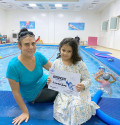
Learning the art of kickboxing can provide children with numerous benefits
2023-10-27 - kick-boxingIntroduction
Kickboxing is not just a sport for adults; it can also be a fantastic activity for kids. Learning the art of kickboxing can provide children with numerous benefits, including physical fitness, discipline, self-confidence, and self-defense skills. In this article, we will explore the world of kickboxing for kids, focusing on how to learn the steps and techniques that can make it a fun and rewarding experience for children.
1. What is kickboxing for Kids?
Kickboxing for kids is a modified version of the sport that incorporates the fundamental techniques of traditional kickboxing while ensuring the safety and well-being of children. It involves a combination of punches, kicks, and defensive maneuvers, making it an exciting and engaging activity.
2. Benefits of Kickboxing for Kids
Before delving into the learning process, it's essential to understand the advantages of kickboxing for kids. Some key benefits include improved physical fitness, enhanced coordination, increased self-confidence, and learning self-defense skills.
Getting Started
3. Choosing the Right Instructor
To kickstart your child's kickboxing journey, it's crucial to find a qualified and experienced instructor who specializes in teaching kids. Look for someone who can create a safe and enjoyable learning environment.
4. Required Gear and Attire
Your child will need some basic gear and attire for kickboxing, including gloves, protective padding, and comfortable clothing. Make sure to purchase the right equipment to ensure their safety during training.
Learning the Techniques
5. Stance and Footwork
Proper stance and footwork are the foundation of kickboxing. Kids should learn how to stand correctly, distribute their weight, and move efficiently in the ring.
6. Punches
Kickboxing involves various types of punches, such as jabs, crosses, hooks, and uppercuts. Teaching kids the proper techniques for these punches is essential.
7. Kicks
Kicking is a significant part of kickboxing. Kids will learn various types of kicks, including front kicks, roundhouse kicks, and sidekicks, among others.
8. Defensive Moves
Children need to master defensive maneuvers, like blocking, parrying, and evading, to protect themselves during sparring or competitions.
The Importance of Practice
9. Consistent Training
Regular practice is the key to mastering kickboxing. Encourage your child to attend classes regularly and practice at home to reinforce what they've learned.
10. Partner Drills
Pairing up with a training partner allows kids to practice their techniques in a controlled and safe environment. Partner drills enhance their skills and build confidence.
Building Self-Confidence
11. Setting Goals
Help your child set achievable goals in kickboxing. It could be mastering a specific technique, earning a belt, or participating in a friendly competition.
12. Positive Reinforcement
Praise and positive reinforcement are crucial in building your child's self-confidence. Acknowledge their progress and effort to keep them motivated.
Safety First
13. The Importance of Safety
Safety should always be a priority in kickboxing for kids. Ensure that your child's instructor follows safety guidelines, and that they are wearing the appropriate protective gear during training.
14. Encourage Open Communication
Teach your child the importance of open communication. They should feel comfortable discussing any concerns or discomfort they may experience during training.
Conclusion
Kickboxing for kids can be an exciting journey filled with valuable life lessons. By choosing the right instructor, focusing on proper techniques, and emphasizing safety and self-confidence, your child can embark on a path to physical fitness and personal growth.
.






.jpg)











































































































































































































